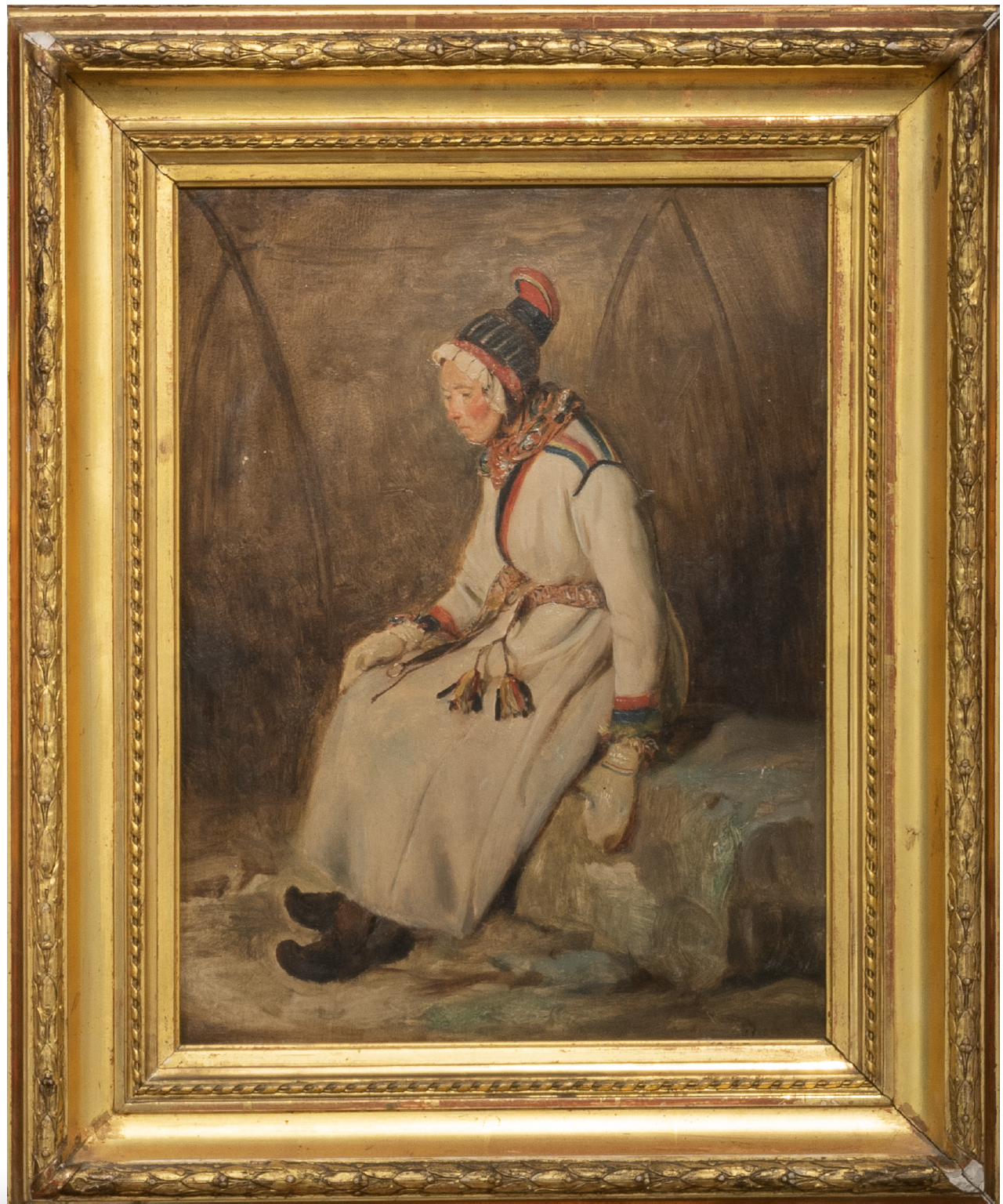François-Auguste Biard, Laponne Nomade Karasuvando, 1839. Oil on paper mounted on canvas. 38.5 x 30 cm. Fridtjof Nansen Institute.
Laponne Nomade Karasuvando (female, nomadic Lapp, Karesuando) is likely one of the fifty-five representations of Sámi individuals the French artist François-Auguste Biard painted, on the spot with the subject in front of him, during his travels through Sápmi in 1839. Painted on paper and measuring 38.5 x 30 cm, Biard’s modest-sized work presents the sitter in Sámi clothing seated on a roughly painted object (perhaps a chest) inside what may be a lávvo. The figure is wearing a long, white dorka decorated with a woven belt, a shawl and a pair of white wool mittens. On her feet she has gámmagat (shoes), and on her head a ládjogahpir, or horn hat. With downcast eyes and leaning slightly forward, she has one hand placed beside her, the other hand on her knee. While her open posture allows ample view to study her dorka, her half-turned position gives us the characteristic profile of the ládjogahpir. The composition reveals a strong interest in the clothing and accessories of the Sámi sitter. But who was she?
The title, Laponne Nomade Karesuando, provides less information about the sitter than it suggests. In fact, it confusingly leads the viewer to believe that the sitter was part of a reindeer-herding community from Gárasavvon (Karesuando), which is situated in the inland on the Swedish side of Sápmi. Yet, as Anne May Olli has pointed out, the woman’s clothing suggests a cultural and familial affinity to the coastal areas of Finnmárku (Finnmark). Alongside his failure to record her given name, Biard’s erroneous labelling reflects the fact that he was not painting a portrait of her. By contrast, she featured as part of his scientific-artistic project of creating a complete visual collection of the world’s different human races. Unlike traditional portraiture, the portrait’s destined place was not with the sitter (nor her friends or family), but in the ‘grand’ museum of natural history in Paris (Boivin 1842: 43).
For the exhibition, the Sámi artist Raisa Porsanger (b. 1988) created an installation that physically and conceptually reframed Biard’s Laponne Nomade Karasuvando. How might this challenge the colonial rhetoric of Biard’s painting? Porsanger’s installation consists of an empty wooden frame decorated with sisti (tanned reindeer skin), dyed goat skin and woollen cloth placed around Biard’s painting. Her reframing creates a dialogue with the woman it envelops, connecting across time Porsanger’s artistic practice of duodji with the sitter’s clothing. Even though the identity and whereabouts of the woman in Biard’s painting remain unknown, Porsanger effectively reclaims the sitter’s dignity and cultural identity by pulling her into a present space of Sámi belonging.
Essay by Ingeborg Høvik
References
Boivin, Louis. 1842. Notice sur M. Biard; ses aventures; son voyage en Laponie, avec Madame Biard; Examen critique de ses Tableaux. Paris. 43
